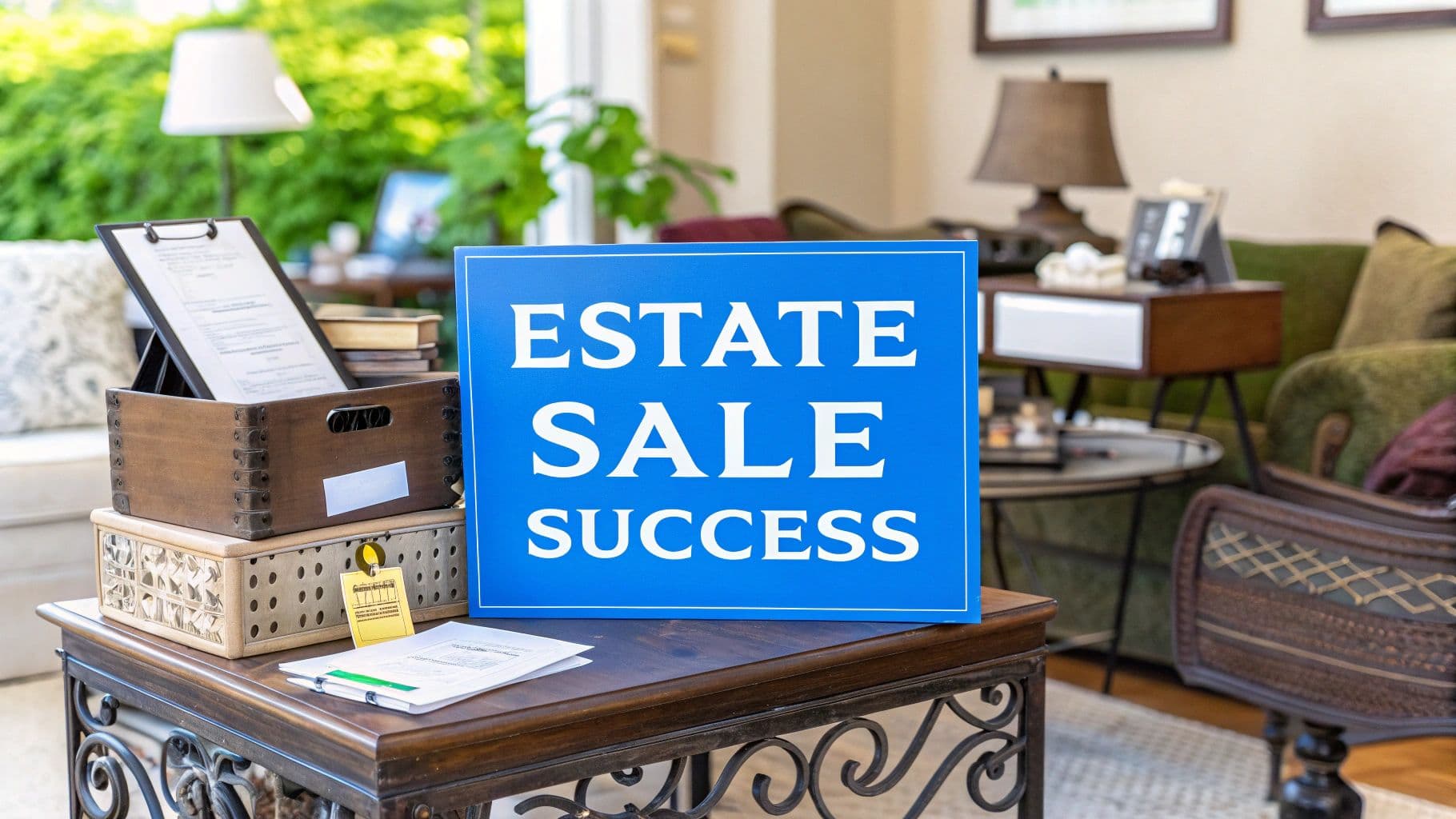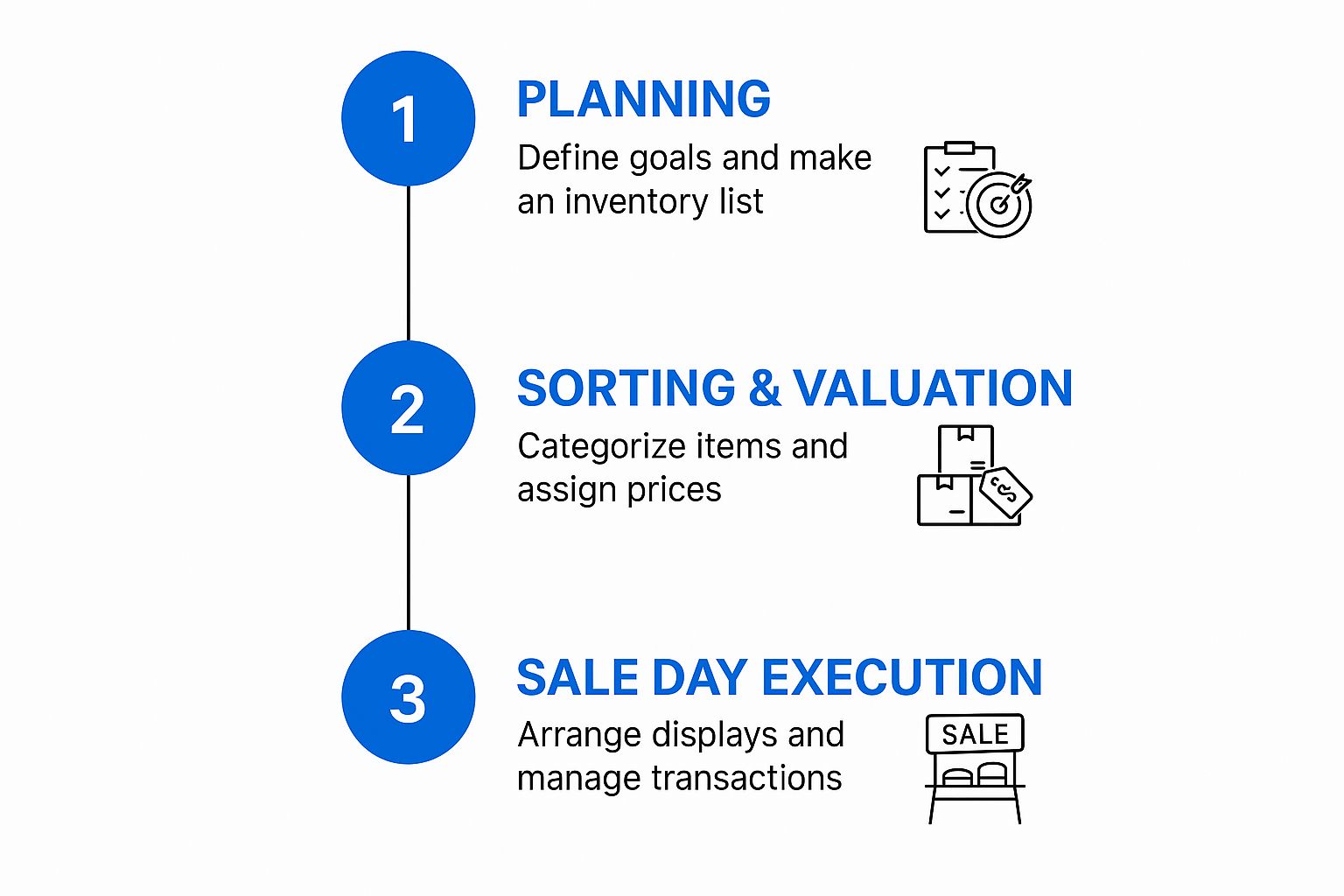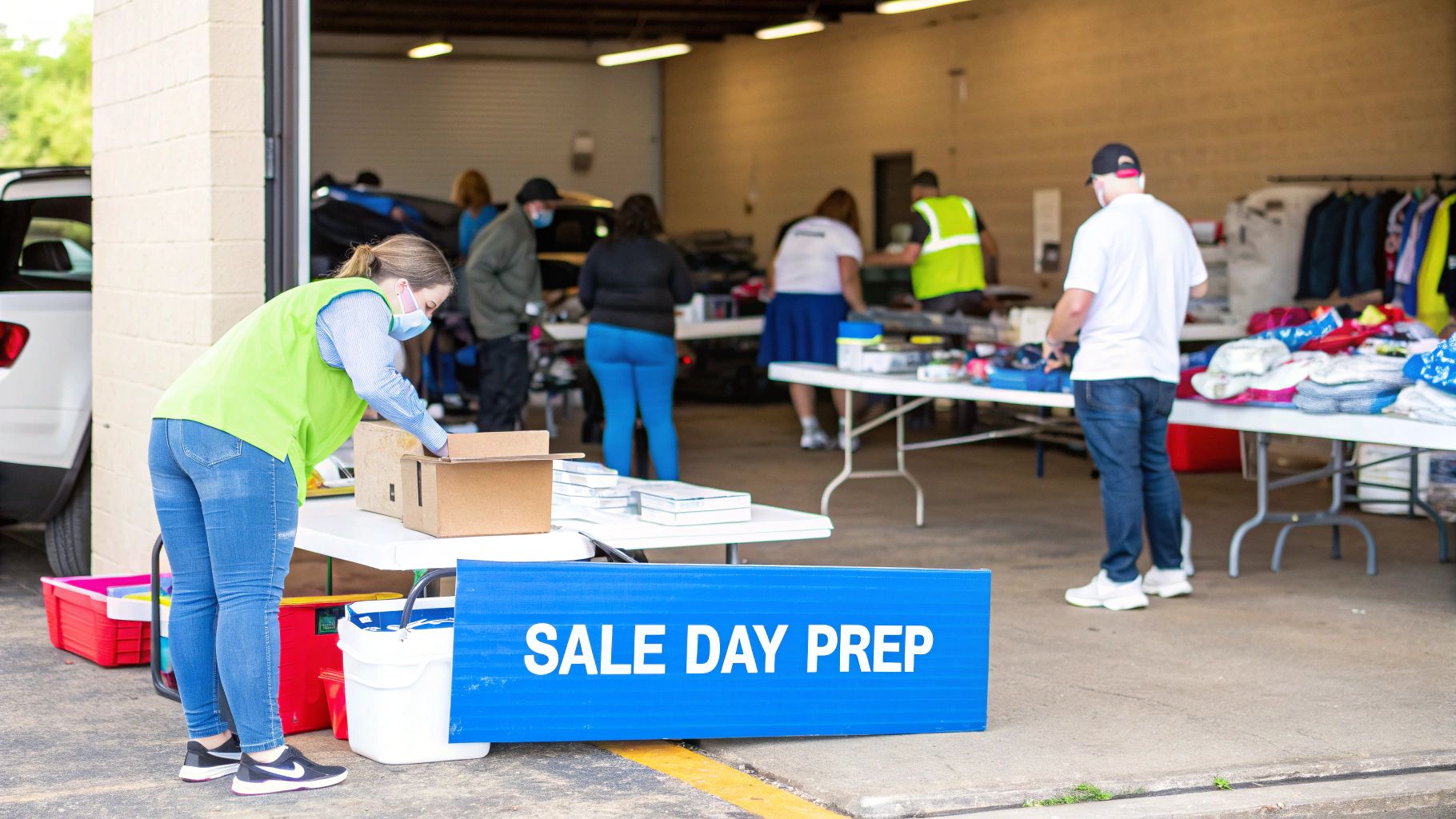Master Estate Sale Organization Tips for Maximum Profits

Creating Your Estate Sale Foundation for Success
The journey of selling a house full of items starts with a single, well-thought-out plan. Strong estate sale organization isn't just about sorting through old belongings; it's about making smart decisions long before the first buyer shows up. This planning phase is what separates a profitable, smooth event from one that feels chaotic and barely breaks even. It all begins with a realistic look at what you have and what you hope to accomplish.
Before you even think about pricing a single teacup, just walk through the house. Get a feel for the sheer volume and general quality of the contents. Are you looking at a home filled with sought-after vintage furniture and rare collectibles, or is it mostly everyday household goods? This first pass is essential because it shapes your goals. Is the main priority to clear the house out by a specific date, or is it to make as much money as possible? Answering that honestly will guide every decision you make from here on out.
Define Your Goals and Timeline
Once you have a better sense of what you're working with, you can set some achievable goals. Getting everyone on the same page, especially when family is involved, is key to keeping the peace. Setting clear objectives—like, "We need the house empty by the end of the month," or "Our goal is to make $5,000 to help with moving expenses"—gives everyone a shared target. From there, you can map out a realistic schedule.
This infographic breaks down the core stages of an estate sale, from the first planning steps to the final sale day.

Seeing the entire process visually can make a massive project feel much more manageable by breaking it into smaller, more approachable phases.
The Professional vs. DIY Decision
This is often the first major fork in the road for families. If the estate includes valuable collections, antiques, or fine art, bringing in a professional company can be a smart move. They have the expertise to value these items correctly and come with a built-in network of serious buyers. On the other hand, if you're comfortable managing the process and the items are fairly standard, a DIY approach using a platform like DIYAuctions gives you complete control and means you keep more of the profits.
To help you decide, here’s a look at how the timeline and effort differ between managing a sale yourself versus hiring a professional company.
Estate Sale Timeline: DIY vs Professional Management
Comparison of time requirements and key milestones for self-managed versus professionally managed estate sales
| Task | DIY Timeline | Professional Timeline | Complexity Level |
|---|---|---|---|
| Initial Consultation & Planning | 2-5 hours (self-assessment) | 1-3 hours (with company) | Low |
| Sorting, Organizing & Decluttering | 20-50+ hours | 0 hours (company handles) | High |
| Researching & Pricing Items | 15-40+ hours | 0 hours (company handles) | High |
| Photography & Cataloging | 10-25 hours | 0 hours (company handles) | Medium |
| Marketing & Promotion | 5-10 hours | 0 hours (company handles) | Medium |
| Running the Sale (Online/In-Person) | 8-20 hours (monitoring/supervising) | 0 hours (company handles) | Medium |
| Managing Pickup/Shipping | 4-8 hours | 0 hours (company handles) | High |
| Final Cleanout & Donations | 5-15 hours | Often included in service | Medium |
This table clearly shows the significant time investment required for a DIY sale. While you save on commission fees, you're trading that for dozens of hours of hands-on work. A professional service takes the entire operational burden off your shoulders but comes at a higher cost.
Looking ahead, the estate sale world is changing. We're seeing more curated, eco-friendly sales, with technology improving the experience for buyers. This shift focuses on sustainability and efficiency, which is great for both sellers and shoppers. You can learn more about how the industry is changing by checking out the latest trends on AcadianaGold.com. Whether you choose the pro or DIY path, adopting some of these modern methods can really make your sale stand out.
Smart Sorting Strategies That Save Time and Sanity
Walking into a house filled with a lifetime of possessions can feel like standing at the base of a mountain. But having a smart plan for sorting is what will get you to the top without losing your mind or momentum. This part of estate sale organization is often the most emotionally draining and time-intensive, but a good strategy makes all the difference. The real objective is to make clear-headed decisions that bring in the most money with the least amount of stress.
The Four-Box Method: Keep, Sell, Donate, Discard
This classic method works because it's simple and decisive. Grab four large boxes or just designate four clear areas in a room you're starting with. Label them:
- Keep: These are the heirlooms and personal items you or your family will be holding onto. Try to be firm and selective to avoid second-guessing later.
- Sell: This box is for everything you think has a resale value. Don't get hung up on pricing just yet—your only job right now is to sort.
- Donate: Items that are in perfectly good shape but might not fetch much at a sale, like everyday clothing or common kitchenware, go here.
- Discard: Anything that's broken beyond repair, stained, or simply unusable. Being honest about what's truly trash will prevent you from cluttering up your sale.
This system forces you to make a choice for every single item, which eliminates that paralyzing "maybe" pile that just eats up time. By tackling the house one room at a time, you'll feel a sense of progress and avoid getting buried. If you pick up an item that tugs at your heartstrings, give yourself a moment, then make a decision and put it in a box. Lingering on these choices is a fast track to burnout.
Identifying and Handling High-Value Items
As you sort, it’s a good idea to have a separate, safe place for potential big-ticket items. Be on the lookout for things like signed art, first-edition books, tools from popular brands, vintage toys still in the box, and any real jewelry. Think of these as the main attractions of your sale.
If you’re not sure what something is worth, put it in this special pile to research later. A quick search on eBay’s "sold" listings can give you a surprisingly accurate picture of what people are actually paying for similar items. For things you suspect are truly valuable, like antiques or fine art, hiring a professional appraiser could be a smart move. Nailing the value of these key pieces is essential; you can find more expert advice on running a successful event in our other guides.
Here's a great example of what a well-organized sale looks like. You can see the wide variety of items that attract all kinds of buyers.

This image shows how presenting a diverse mix of goods—from big furniture pieces to smaller collectibles—can make your sale more appealing. This is the kind of visual variety and organization you should be aiming for.
Pricing Psychology That Moves Inventory Fast
When you're organizing an estate sale, your pricing strategy is everything. It's not about slapping a sticker on an item and hoping for the best; it’s about understanding what makes people decide to buy. You need to find that perfect balance where shoppers feel like they've discovered an amazing deal, and you're still hitting your financial targets. Think of it less as a series of negotiations and more as creating an atmosphere that keeps items flying off the shelves.
The Power of Perceived Value
Let's talk about a simple but incredibly effective trick: charm pricing. An item priced at $18 will almost always sell faster than the same item priced at $20. Why? Because our brains read from left to right, and that first digit—the "1"—anchors our perception of the price as being much lower. It might seem like a small detail, but these psychological nudges add up to a huge difference in how much you sell.
Bundling is another great move, especially for smaller, lower-value goods. Instead of trying to sell individual paperback books for $1 each, which can be a slow process, try offering them as "4 for $3." This encourages people to buy more and helps you clear out items that might get overlooked otherwise. Imagine a box of random kitchen utensils; selling them one by one is a headache. But grouping them as "Entire Box for $5" turns it into a can't-miss bargain for someone setting up their first apartment.
Strategic Pricing by Category
You can't price a vintage armchair the same way you price a set of coffee mugs. Each category needs its own approach to get the best return. It’s also smart to keep an eye on the wider economy. For instance, shifts in the housing market can create more demand for home goods as people move. Keeping tabs on current real estate trends can give you an edge in setting prices that reflect what buyers are willing to pay.
To give you a starting point, here is a breakdown of common pricing guidelines. Think of this as a reference, not a rigid set of rules, as every sale is unique.
Estate Sale Pricing Guidelines by Category
Recommended pricing ranges as percentages of retail value for different item categories
| Item Category | Typical Estate Sale Price | Factors Affecting Price | Best Selling Days |
|---|---|---|---|
| Furniture (Modern) | 20-40% of Retail | Condition, Brand, Current Styles | Friday & Saturday |
| Antiques/Collectibles | Varies (Research is Key) | Rarity, Provenance, Condition | Friday (for collectors) |
| Electronics (Working) | 15-30% of Retail | Age, Model, Included Accessories | Saturday Morning |
| Clothing & Accessories | 10-25% of Retail | Brand, Condition, Seasonality | Sunday (for discounts) |
| Kitchenware & Decor | 10-20% of Retail | Set vs. Individual, Brand Name | All Days |
Using a framework like this helps you price items confidently and consistently. When you blend these smart pricing tactics with a bit of market awareness, you're not just selling more stuff—you're creating a better, more exciting experience for your shoppers, which is the key to a successful sale.
Marketing That Brings Serious Buyers to Your Door
You've sorted the treasures and priced everything perfectly, but none of that work matters if nobody shows up. Smart marketing is what connects your organized estate sale with a crowd of enthusiastic buyers. This isn’t about just throwing a few signs on street corners; it’s about attracting the right people—those who are ready to buy, not just browse. Your plan for getting the word out should be just as thoughtful as your pricing strategy.

Crafting a Compelling Sale Description
Think of your sale description as your most important advertisement. It’s your chance to tell a story and create excitement. Instead of a dry list, lead with your most sought-after items. For instance, don't just say "furniture for sale"—get specific with "Mid-Century Modern Walnut Credenza and Solid Oak Dining Set."
Here’s a simple formula for writing a description that gets results:
- Create a Catchy Headline: Something like "Vintage Collector's Dream & Quality Household Goods!" grabs attention.
- Show Off the Highlights: Immediately list 5-7 of your best items. Mention brands, materials, and condition. For example: "Featuring a collection of sterling silver flatware, signed art prints, and a garage full of well-maintained Craftsman power tools."
- Break Down the Categories: Give shoppers a quick overview of what else to expect, such as "kitchenware, men's clothing, vintage vinyl records, outdoor furniture."
- Provide the Logistics: Clearly state the sale address, dates, and times. Add important rules like "cash and Venmo accepted" or "please bring your own bags and help for heavy items."
Choosing Your Marketing Channels
To spread the word, you need to go where the buyers are. While a few well-placed neighborhood signs are still a good idea, your energy is best spent online. This is where platforms like DIYAuctions shine. They are built to handle the marketing for you, connecting your sale with a local network of verified buyers who are actively searching for sales just like yours. This focused approach saves you a ton of time and makes sure your ads are seen by serious shoppers.
Using online platforms is part of a bigger change in how estate sales are run. Digital marketing is now a key tool for reaching more people and running sales more effectively. To see how things are changing, you can find more information about 2025 estate sale trends on AcadianaGold.com.
The Power of Great Photography
Your photos are just as important as your words. Dark, blurry, or cluttered pictures can make potential buyers scroll right past your listing. You don’t need fancy equipment; your smartphone will do the job perfectly. The secret is staging and lighting.
Before taking a photo, clear the space around the item you're featuring, give it a quick wipe-down, and take the picture near a window to use natural light. For categories like tools or kitchenware, you can take group shots. But for your star items, give them their own individual "glamour shot." These quality images are often the deciding factor that convinces someone your sale is worth the trip.
Strategic Setup That Maximizes Every Sale
After sorting and pricing, the next crucial step is setting up the physical layout of your sale. The way you arrange everything has a huge impact on how shoppers navigate the space and, most importantly, how much they purchase. Your goal is to create a welcoming atmosphere that feels less like a cluttered house and more like a unique shop, making it easy for people to explore and buy.

Creating a Natural Traffic Flow
Think about your home’s layout like a treasure map for your customers. You want to guide them on a journey from the front door to the checkout without causing traffic jams.
- Establish a Clear Path: Place your most attractive items, like big furniture pieces or striking collectibles, near the entrance to pull people in. Arrange tables and displays from there to create a logical, one-way loop through the main rooms.
- Avoid Dead Ends: Try to ensure every room has a clear entrance and exit. A room with only one door can become a bottleneck, especially when it gets busy. If you have to use a room like this, consider limiting how many people can go in at once.
- Group Like Items: Think like a department store. Keep all the kitchenware in the kitchen, tools in the garage, and clothes in the bedrooms. This helps shoppers find what they’re looking for and often leads to them spotting other related items they didn't know they wanted.
Display Techniques That Sell
Good presentation can make a $10 item feel like a real find. Don’t just throw things on a table; arrange them with care. For instance, instead of a jumble of glassware, line it up neatly on a shelf with good lighting. If you’re selling a dining set, set the table with placemats and dishes to help buyers imagine it in their own homes. The more effort you put into presentation, the more value buyers will see.
This is also why a dedicated checkout area is a must. Set up a single, clearly marked station near an exit. Have everything ready: a cash box with plenty of change, a card reader, and lots of bags. A smooth payment process leaves a great final impression. Managing sales and inventory this way can feel overwhelming, but using a dedicated tool can make a world of difference. To see how technology can simplify things, check out this helpful guide on estate sale software and its benefits. This professional touch ensures the entire shopping experience is seamless from start to finish.
Mastering Sale Day Like a Seasoned Professional
When the doors open, the energy shifts. All your careful planning and estate sale organization come down to this moment, and managing it well is the final piece of the puzzle. Sale day isn’t so much about organizing items as it is about organizing people—both your customers and your helpers. Your main goals are to keep the environment secure, make transactions flow smoothly, and maintain a positive, exciting atmosphere. It’s a fast-moving situation, but with a good game plan, you can handle it like an expert.
One of the first things you'll encounter is the "early bird" phenomenon. These are the eager buyers who arrive well before your official start time. While their enthusiasm is great, letting them in early isn't fair to others and can cause chaos. Politely but firmly stick to your start time. A simple, friendly statement like, "We're so glad you're here! We'll be opening the doors right at 9 AM to make sure everyone has a fair chance" works perfectly.
Navigating Negotiations and Customer Flow
Haggling is a natural part of any estate sale, but you don't need to be intimidated by it. Expect shoppers to ask for a better price, especially on bigger items. Before the sale, decide on your absolute rock-bottom price for key pieces so you can respond with confidence. A great tactic is to offer a small discount for customers who buy multiple items. For example, you could say, "I can't go lower on that chair alone, but if you take the side table with it, I can knock $5 off the total." This tactic encourages bundling and helps you move more inventory.
To manage the flow of people and keep everything secure, it's smart to have helpers. Give each person a specific role:
- The Greeter: This person should be at the entrance to welcome people, answer quick questions, and keep an eye on how many shoppers are inside at once.
- The Roamer: This helper walks through the sale areas to answer questions on the floor, discourage theft, and tidy up displays as items get sold.
- The Cashier: This person handles all the payments at a single, designated checkout station.
This division of labor keeps things running efficiently and frees you up to oversee the entire operation. It's a strategy that professional services use to make the process feel seamless for everyone involved. The broader real estate market, often linked with estate liquidations, is also experiencing major shifts. Global real estate investment is projected to go past $950 billion by 2025, which can signal more activity in home contents sales. You can read more about the factors driving real estate growth on Chambers.com to understand these larger trends.
Key Takeaways
Running a great estate sale organization comes down to a mix of thoughtful planning, a little psychology, and good old-fashioned work. It begins with a solid plan, from sorting every last item to setting prices that make shoppers feel like they're getting a deal. Don't forget the little tricks, like charm pricing ($18 often sells better than $20) and bundling small items to clear them out faster.
Your Action Plan for Success
The way you set up the sale is just as critical as what you're selling. Think like a retailer and create a clear path for shoppers to follow. Grouping similar items—like all kitchenware in one area and all tools in another—creates a mini-department store feel. This simple organization encourages people to browse longer and, ultimately, buy more. Your marketing should lean on high-quality photos and detailed descriptions of your best items to draw in serious buyers from the get-go.
- Plan with Purpose: Set clear goals and a realistic schedule before you start.
- Price to Move: Use research and a bit of pricing psychology to turn items over quickly.
- Stage for Sales: Design an inviting layout that shows off your items and guides customers smoothly.
- Market Smartly: Use compelling photos and descriptions on the right platforms to build excitement.
Handling Post-Sale Logistics
When the last customer leaves, your work isn't quite done. You need a strategy for everything that didn't sell, whether that means donating items to a local charity or calling a junk removal service to handle the rest. The end goal is to leave the property completely empty. After that, it's time to tally up your earnings and see how you did against your original goals. This final step brings a real sense of accomplishment. To fine-tune your approach, be sure to check out our ultimate estate sale FAQ for answers to common questions.